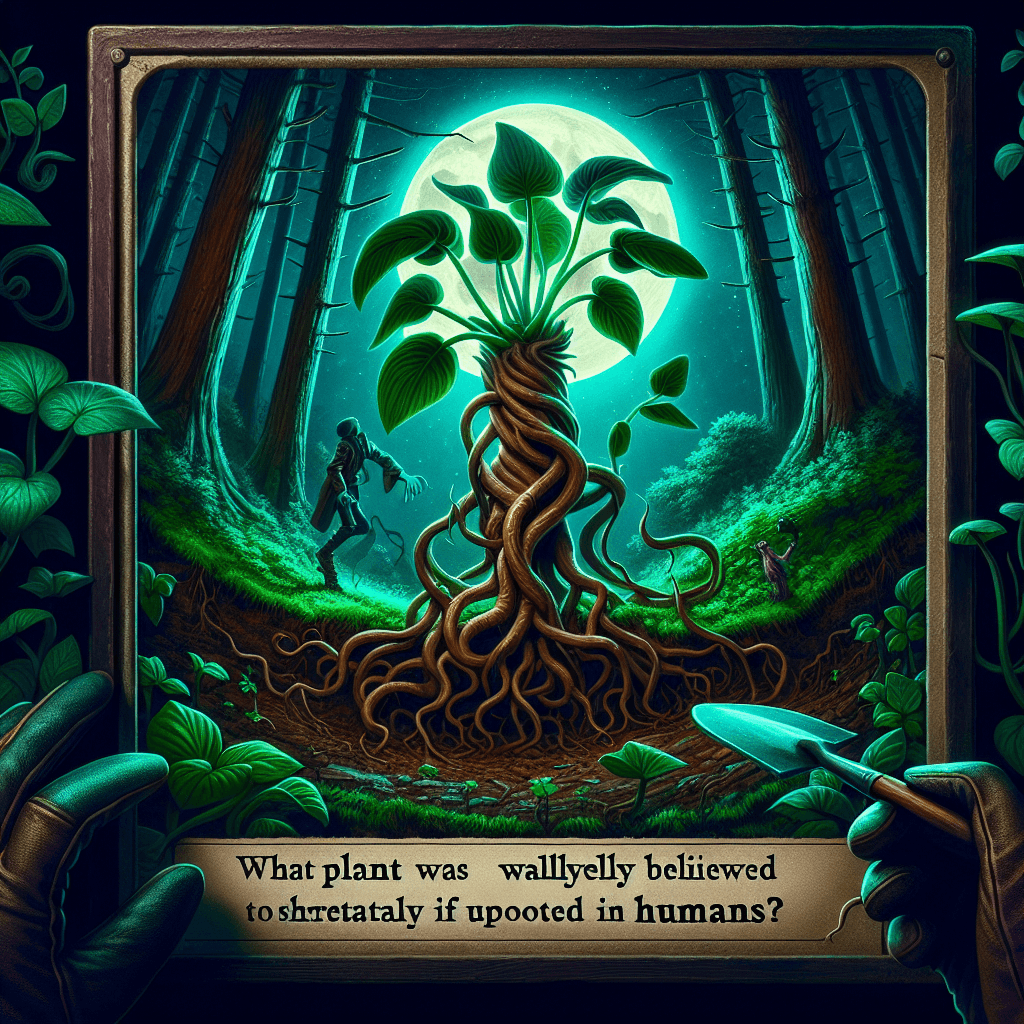The Fatal Flora: Unearthing the Legend of the Screaming Mandrake
Unearth the chilling legend of the Mandrake, a plant whose shriek was once believed to be fatal to any human who dared to pull it from the ground.


Too Long; Didn't Read
The Mandrake plant was widely believed to let out a fatal shriek when uprooted by humans.
The Fatal Flora: What Plant Was Widely Believed to Shriek Fatally if Uprooted by Humans?
Imagine a plant so steeped in mystique that its very unearthing was said to unleash a sound deadly to any human who heard it. This wasn't just a fanciful tale whispered in hushed tones; for centuries, it was a widely held belief surrounding a particular botanical specimen. This blog post delves into the fascinating folklore and facts behind the plant infamous for its lethal shriek: the Mandrake. We'll unearth the history, the legends, and the truths behind this extraordinary plant.
The Mandrake: More Than Just a Root
The plant at the heart of this deadly legend is the Mandrake (genus Mandragora, typically Mandragora officinarum). Native to the Mediterranean region and parts of Asia, the Mandrake is a perennial herbaceous plant with a long, thick taproot, often forked, which strikingly resembles a human figure. This anthropomorphic appearance was a significant factor in the rich tapestry of myths woven around it.
Historically, the Mandrake was highly valued for its medicinal properties. Ancient texts, including those by Greek physician Dioscorides in the 1st century AD, document its use as an anesthetic, a pain reliever, and a soporific. Its psychoactive compounds, primarily tropane alkaloids like scopolamine and hyoscyamine, contributed to both its medicinal applications and its association with magic and witchcraft.
The Legend of the Deadly Shriek
The most notorious piece of Mandrake folklore is undoubtedly the belief that it would emit a bloodcurdling shriek when pulled from the ground. This scream was said to be so powerful that it could instantly kill or drive mad anyone unfortunate enough to hear it.
This belief, prevalent throughout the Middle Ages and into the Renaissance, made harvesting the Mandrake a perilous undertaking. Why such a terrifying legend? Several theories exist:
- Protecting a Valuable Resource: The extreme danger associated with its harvest could have been a way to deter amateur collectors, ensuring that only those with specialized (and perhaps guarded) knowledge could obtain it, thereby maintaining its high value.
- Anthropomorphism: The human-like shape of the root likely fueled the idea that it possessed human-like qualities, including the ability to cry out in pain.
- Psychoactive Effects: Those who improperly handled or ingested parts of the plant might have experienced hallucinations or delirium, which could have been interpreted or embellished into tales of a fatal scream.
Rituals of Uprooting: Dodging Death's Cry
Given the supposed lethality of the Mandrake's shriek, elaborate rituals were devised to harvest it safely. The most famous method, described by various historical writers including Pliny the Elder and Josephus, involved using a dog:
- Loosening the Soil: The harvester would carefully dig around the base of the Mandrake plant to loosen the soil, exposing the top of the root.
- Tying the Knot: A strong cord would be tied around the exposed root.
- The Canine Assistant: The other end of the cord was then fastened to a dog, often one described as black and starved to ensure its eagerness.
- Luring the Dog: The harvester would then offer food to the dog from a distance, or simply retreat. As the hungry dog lunged for the food or tried to follow its master, it would pull the Mandrake root from the ground.
- The Sacrifice: According to legend, the dog would hear the fatal shriek and perish, thus sparing the human harvester. The harvester would typically plug their own ears with wax or cotton as an added precaution.
Other rituals included drawing circles around the plant, reciting incantations, and harvesting only at specific times, such as at night or under a full moon, often facing away from the plant.
Fact, Folklore, and Enduring Fascination
Scientifically, of course, plants do not possess vocal cords or the biological mechanisms to "shriek" in the human sense. The sounds, if any, might have been the natural noises of roots tearing from the earth, the wind, or perhaps the distressed cries of the dog used in the harvesting process.
Despite the lack of a literal scream, the Mandrake’s potent chemical composition and its human-like form cemented its place in folklore, medicine, and literature for millennia. It appears in works from Shakespeare's plays (Juliet speaks of "shrieks like mandrakes' torn out of the earth, That living mortals, hearing them, run mad") to modern fantasy like J.K. Rowling's Harry Potter series.
The tale of the shrieking Mandrake serves as a captivating example of how folklore can intertwine with the natural world. It highlights humanity's age-old fascination with plants that possess both healing properties and an aura of the mysterious or dangerous. While we now understand the science behind the Mandrake's properties and can dismiss the fatal shriek as pure legend, its story remains a potent reminder of the power of belief and the enduring allure of the natural world's more enigmatic inhabitants. The Mandrake continues to fascinate, a silent testament to a time when myth and medicine were deeply entwined.


